  Help Help
|
Controls |
| To move: click/touch the mini-map to teleport to a location inside the tomb, or click/touch and drag to move. |
| To look around: click/touch and drag on the 3D view |
|
 | - | Reset to the initial view |
 | - | Show hotspots: click/touch the exclamation marks to have more information |
|
| VISIT THE OUTSIDE OF THE TOMB | - | Switch to the OUTSIDE virtual visit |
Credits
An initiative of: City of Sesto Fiorentino, Sesto Fiorentino Tourism Association Proloco, SABAP - Soprintendenza Archeologia Belle Arti e Paesaggio per la città metropolitana di Firenze e per le province di Pistoia e Prato.
Virtual tour: Institute of Science and Technologies of Information, Pisa (ISTI-CNR) and Institute of Sciences of the Cultural Patrimony, Florence (ISPC-CNR, ex ICVBC).
3D Survey: Sistemi Integrati di Monitoraggio Architettonico: SI∑MA
Project supported by Publiacqua S.p.A.
No etruscans were harmed in the making of the of this virtual tour.
|
  Dromos - outer Dromos - outer
|
The access to the main structure is a long open-ceiling corridor (Dromos) that cuts through the mound. Around 14 meters long and 2 meters wide, the dromos is made of squared blocks of alberese stone with a rough finish. |
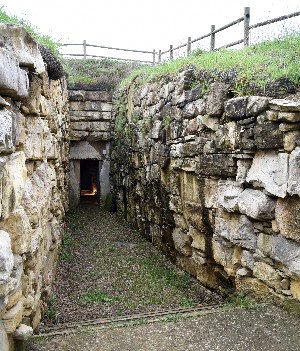 |
The blocks, while irregular in their sizes, are nevertheless arranged in regular rows, with their gaps filled with smaller stones. This retaining wall is made “a secco” (dry stone), without mortar. |
  Door stone slab Door stone slab
|
This large sandstone slab, now resting o the side of the access to the inner part of the tomb, was probably used as a closure between the inner and outer dromos (corridors). |
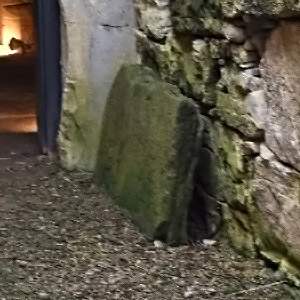 | It is very common, for this kind of tombs, generally owned by a single family, to be re-opened multiple times, both for new depositions and for periodical ritual events. |
  Dromos - inner Dromos - inner
|
The inner dromos (corridor), is also made of alberese stone, but it is using larger blocks with respect to the outer part, and with fewer filler stones. The structure is covered by a double-sloped ceiling of large rough stone slabs. |
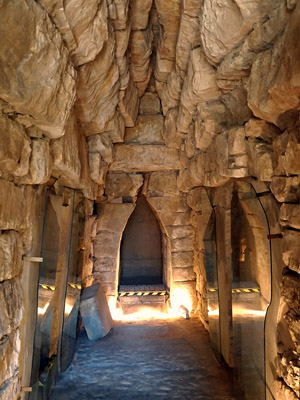 |
At around halfway in the inner dromos, we can see the openings to the two side cells, sided by large stone slabs. At the end of the dromos, a narrow passage leads to the central Tholos chamber. |
  Side cells Side cells
|
The entrances to the side cells are framed by two large, smooth stone slabs and an imposing architrave. |
 |
The stone slabs framing the entrances to the cells, originally, were decorated. The ones of the left cell still show layers of burnt Siena and cyan color; on the ones on the right are visible remains of complex graffiti, with a grazing light, it is possible to see letters and sketches of plants and animals. |
  Left cell Left cell
|
Inside the left cell, it is possible to see a cube of volcanic tuff with a concavity on its upper side, and a stone slab. They both have been found in this position during the excavation. |
 | The cube is carved out of volcanic tuff, coming from the quarries of the nearby Calenzano, and was probably used as a support for a lebète, a wide-mouth cauldron, metal or ceramic, used to heat up water, cook meals, and for ritual washes in religious ceremonies, weddings and funerals. |
  Right cell Right cell
|
On the back of the cell, it is clearly visible the missing part of the stone wall (now closed using concrete), opened by looters to enter the tomb. On the ground, close to the entrance of the cell, a stone slab of uncertain function. |
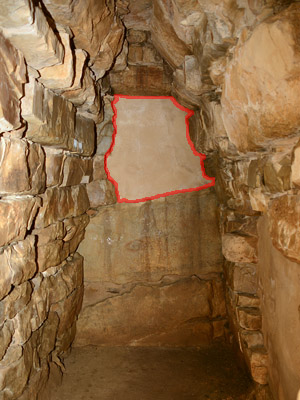 | The tomb was looted way back before the archaeological excavation, through galleries dug on the sides of the mound, reaching the side cells. |
  Carved stone slab Carved stone slab
|
Near the passage to the Tholos (false-dome chamber) there is a stone slab in volcanic tuff. It is possible the slab was part of the stone structure of the passage, or that it was carved but never actually fitted in its intended place. |
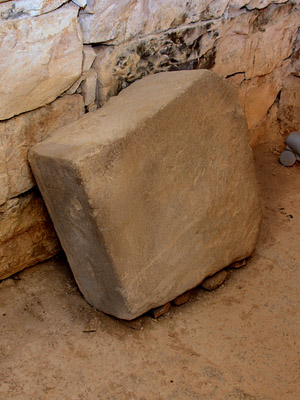 | The slab has been flattened and smoothed only on three sides, while cutting the others below level, to help the fitting process. This technique is known as anathyrosis, and was frequently used in ancient buildings. |
  Passage Passage
|
The entrance of the Tholos (false-dome chamber), is a narrow passage with a pointed-arch outline, made of neatly stacked sandstone slabs, more regular and smooth than the rest of the structure. |
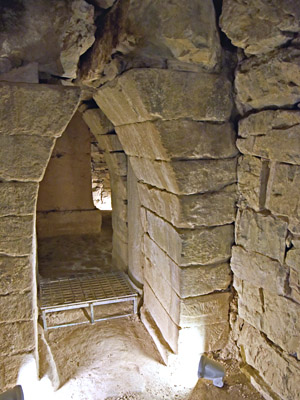 | This passage, 2 meters long, is much narrower than the dromos and it is cut in half by two vertical slabs of stones on the sides, and a rounded stepping stone on the ground. |
  Tholos Tholos
|
The false-dome chamber, called Tholos is the most secluded part of the structure, and the largest room of the tomb. |
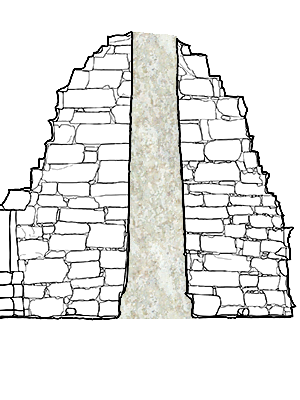 | The tholos has a diameter of around 5 meters, and a similar height. The walls are made of rings of stones, neatly layered one on top of the other. While in the lower part they are mostly of the same girth, forming a cylinder, they get progressively smaller, defining the dome-shape. |
  Pillar Pillar
|
The central pillar, heavily tapered in the upper part, is made of multiple sections of volcanic tuff coming from the quarries of the nearby Calenzano. The pillar does not support the false dome (which is, like all these structures, self-supporting). Its original function is still partly unknown today, but may be just decorative or symbolic. |
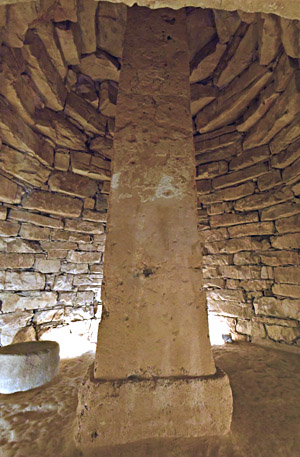 | The pillar is resting on a wider base, going down in the ground for around 20cm. Originally, it was covered by a layer of dark clay (still visible), acting like plaster, and probably decorated. On all sides it is possible to see the remains of iron nails, probably used to hang the object of the funerary accessories. |
  Sandstone cylinder Sandstone cylinder
|
The sandstone cylinder on the ground, similarly to the stone cube in the left cell, may have been used as support for a lebète . |
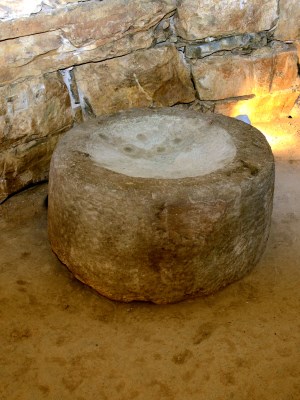 | A lebète is a wide-mouth cauldron, metal or ceramic, used to heat up water, cook meals, and for ritual washes in religious ceremonies, weddings and funerals. |
|











